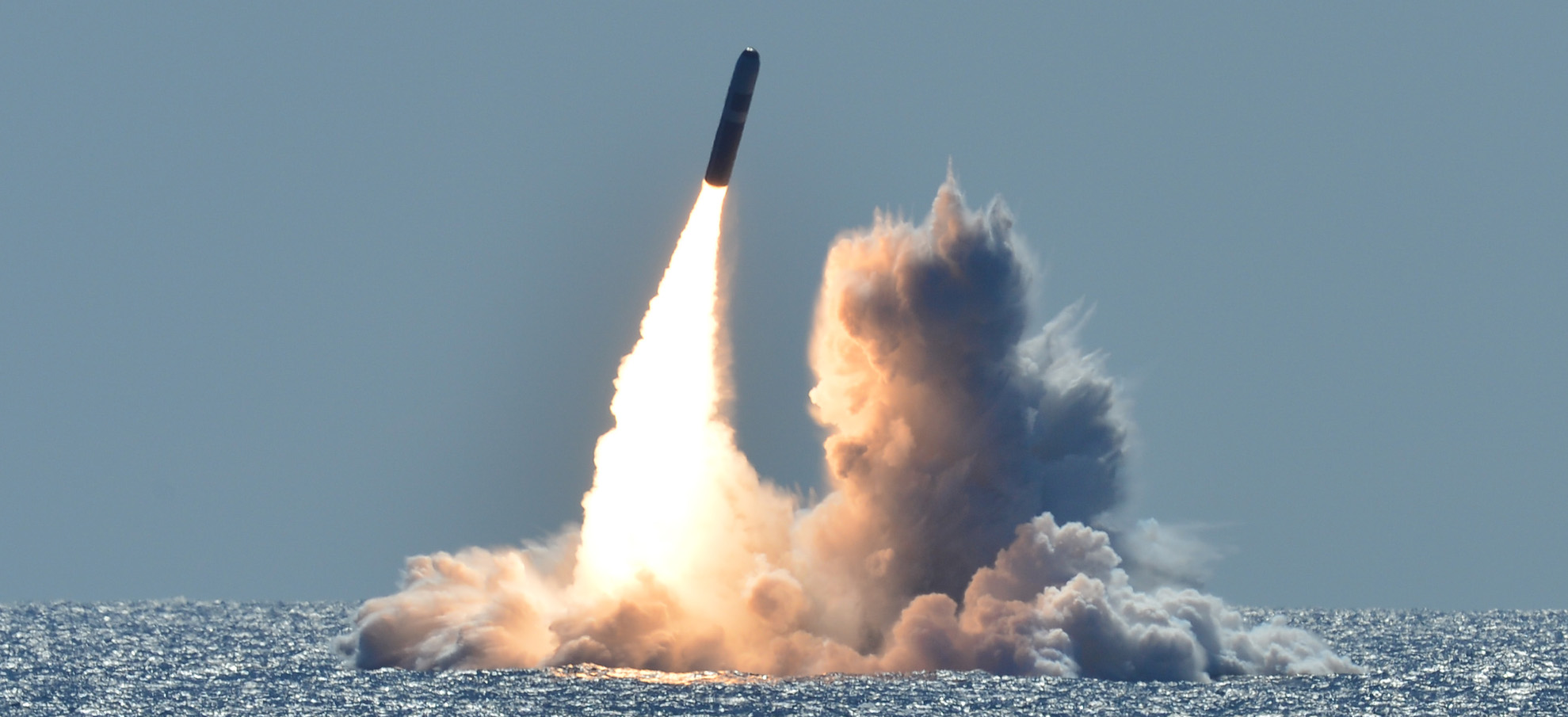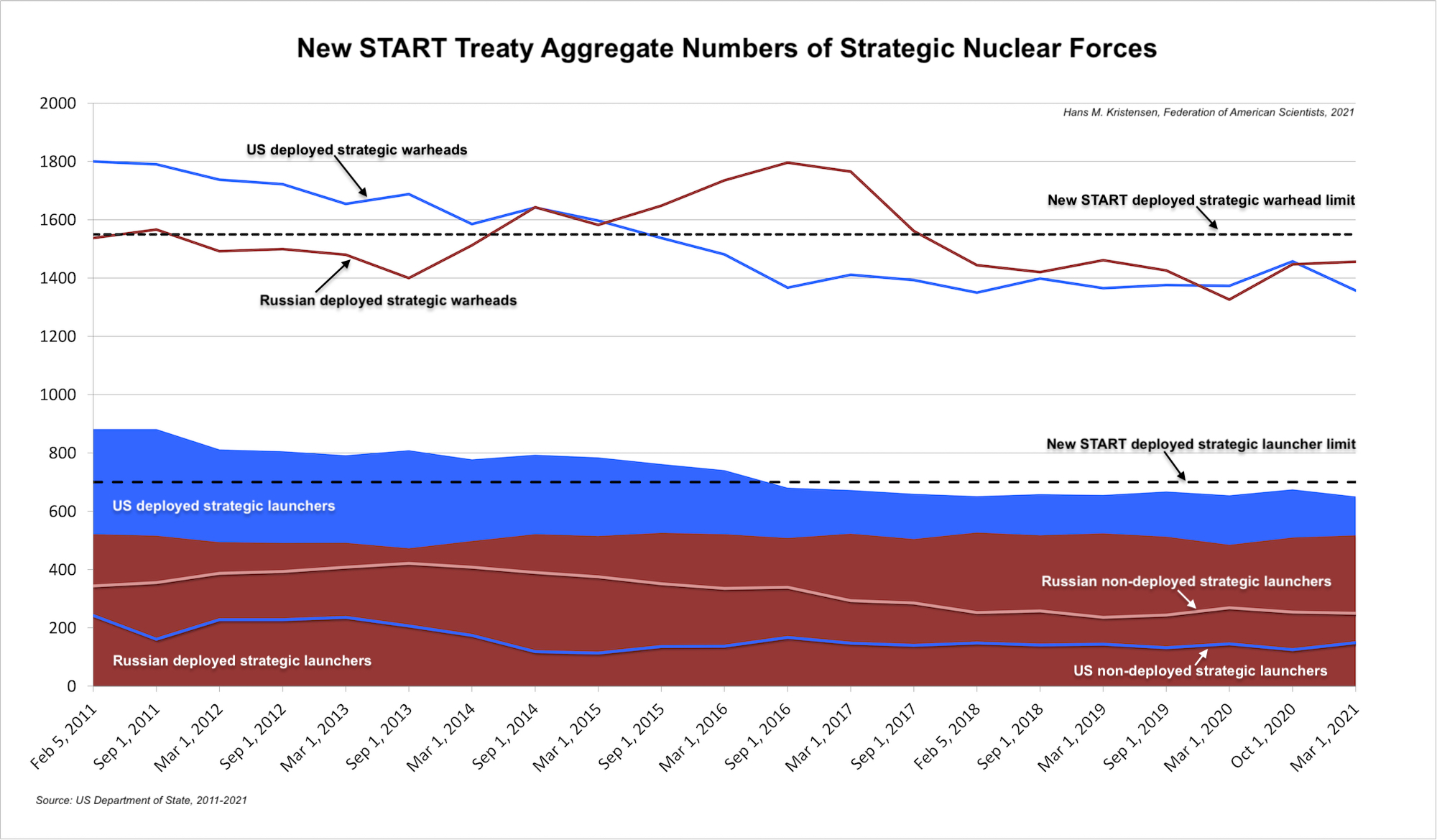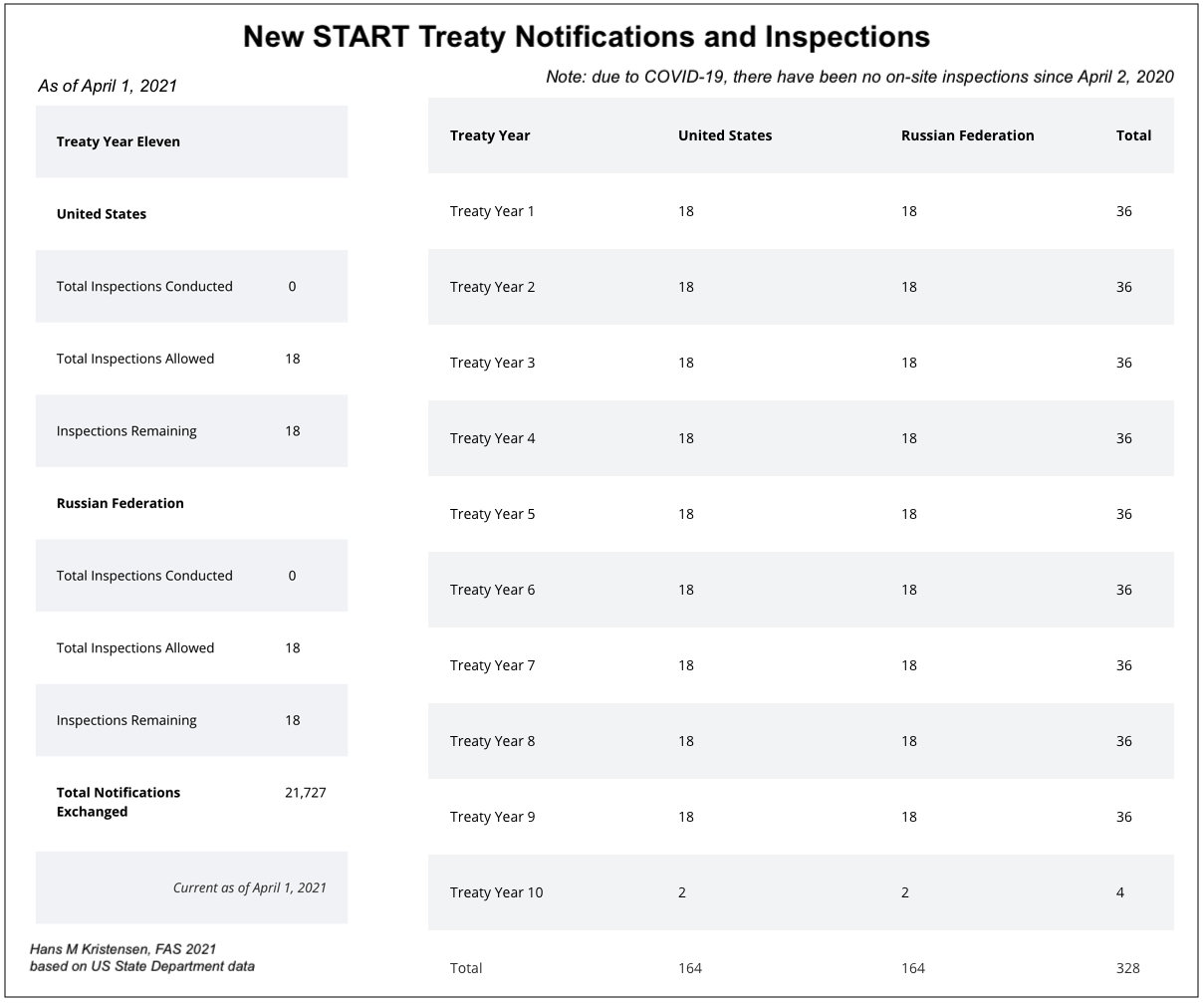First New START Data After Extension Shows Compliance
The first public release of New START aggregate numbers since the United States and Russia in February extended the agreement for five years shows the treaty continues to limit the two nuclear powers strategic offensive nuclear forces.
Continued adherence to the New START limits is one of the few positive signs in the otherwise frosty relations between the two countries.
The ten years of aggregate data published so far looks like this:
Combined Forces
The latest set of this data shows the situation as of March 1, 2021. As of that date, the two countries possessed a combined total of 1,567 accountable strategic missiles and heavy bombers, of which 1,168 launchers were deployed with 2,813 warheads. That is a slight decrease in the number of deployed launchers and warheads compared with six months ago (note: the combined warhead number is actually about 100 too high because each deployed bomber is counted as one weapon even though neither country’s bombers carry weapons under normal circumstances).
Compared with September 2020, the data shows the two countries combined increased the total number of strategic launchers by 3, decreased combined deployed strategic launchers by 17, and decreased the combined deployed strategic warheads by 91. Of these numbers, only the “3” is real; the other changes reflect natural fluctuations as launchers move in and out of maintenance or are being upgraded.
In terms of the total effect of the treaty, the data shows the two countries since February 2011 combined have cut 422 strategic launchers from their arsenals, reduced deployed strategic launchers by 235, and reduced the number of deployed strategic warheads by 524. However, it is important to remind that this warhead reduction is but a fraction (just over 6 percent) of the estimated 8,297 warheads that remain in the two countries combined nuclear weapons stockpiles (just over 4 percent if counting their total combined inventories of 11,807 stockpiled and retired (but yet to be dismantled) warheads).
The United States
The data shows the United States currently possessing 800 strategic launchers, exactly the maxim number allowed by the treaty, of which 651 are deployed with 1,357 warheads attributed to them. This is a decrease of 24 deployed strategic launchers and 100 deployed strategic warheads over the past 6 months. These are not actual decreases but reflect normal fluctuations caused by launchers moving in and out of maintenance. The United States has not reduced its total inventory of strategic launchers since 2017.
The aggregate data does not reveal how many warheads are attributed to the three legs of the triad. The full unclassified data set will be released later. But if one assumes the number of deployed bombers and deployed ICBMs are the same as in the September 2020 data, then the SSBNs carry 909 warheads on 200 deployed Trident II SLBMs. That is a decrease of 100 warheads on the SSBN force compared with September, or an average of 4-5 warheads per deployed missile. Overall, this accounts for 67 percent of all the 1,357 warheads attributed to the deployed strategic launchers (nearly 70 percent if excluding the “fake” 50 bomber weapons included in the official count).

The New START data indicates that the United States as of March 1, 2021 deployed approximately 909 warheads on ballistic missile onboard its strategic submarines.
Compared with February 2011, the United States has reduced its inventory of strategic launchers by 324, deployed launchers by 231, and deployed strategic warheads by 443. While important, the warhead reduction represents only a small fraction (about 12 percent) of the 3,800 warheads that remain in the U.S. stockpile (less than 8 percent if counting total inventory of 5,800 stockpiled and retired (but yet to be dismantled) warheads).
The Russian Federation
The New START data shows Russia with an inventory of 767 strategic launchers, of which 517 are deployed with 1,456 warheads attributed to them. Compared with six months ago, this is an increase of 7 deployed launchers and 9 deployed strategic warheads. The change reflects fluctuations caused by launcher maintenance and upgrade work to new systems.
Compared with February 2011, Russia has cut its inventory of strategic launchers by 98, deployed launchers by 4, and deployed strategic warheads by 81. This modest warhead reduction represents less than 2 percent of the estimated 4,497 warheads that remain in Russia’s nuclear weapons stockpile (only 1.3 percent if counting the total inventory of 6,257 stockpiled and retired (but yet to be dismantled) Russian warheads).
Compared with 2011, the Russian reductions accomplished under New START are smaller than the U.S. reductions because Russia had fewer strategic forces than the United States when the treaty entered into force in 2011.
Build-up, What Build-up?
With frequent claims by U.S. officials that Russia is increasing its nuclear arsenal, which may be happening in some categories, it is interesting that despite a significant modernization program, the New START data shows this increase is not happening in the size of Russia’s accountable strategic nuclear forces. (The number of strategic-range nuclear forces outside New START is minuscule.)
On the contrary, the New START data shows that Russia has 134 deployed strategic launchers less than the United States, a significant gap roughly equal to the number of missiles in an entire US Air Force ICBM wing. It is significant that Russia despite its modernization programs so far has not sought to reduce this gap by deploying more strategic launchers. Instead, the Russian launcher deficit has been increasing by nearly one-third since its lowest point in February 2018.

Although Russia is modernizing its nuclear forces, such as those of this SS-27 Mod 2 (RS-24, Yars) ICBM exercise near Bernaul, this has not yet resulted in an increase of its strategic nuclear weapons.
Instead, the Russian military appears to try to compensate for the launcher disparity by increasing the number of warheads that can be carried on the newer missiles (SS-27 Mod 2, Yars, and SS-N-32, Bulava) that are replacing older types (SS-25, Topol, and SS-N-18, Vysota). Thanks to the New START treaty limit, many of these warheads are not deployed on the missiles under normal circumstance but are stored and could potentially be uploaded onto the launchers in a crisis. The United States also has such an upload capability for its larger inventory of launchers and therefore is not at a strategic disadvantage.
Two of Russia’s new strategic nuclear weapons (SS-19 Mod 4, Avangard, and SS-29, Sarmat) are covered by New START if formally incorporated. Other types (Poseidon nuclear-powered torpedo, and Burevestnik nuclear-powered ground-launched cruise missile) are not yet deployed and appear to be planned in relatively small numbers. They do not appear capable of upsetting the strategic balance in the foreseeable future. The treaty includes provisions for including new weapon types, if the two sides agree.
Inspections and Notifications
In addition to the New START data, the U.S. State Department has also updated the overview of part of its treaty verification activities. The data shows that the two sides since February 2011 have carried out 328 on-site inspections of each other’s strategic nuclear forces and exchanged 21,727 notifications of launcher movements and activities. Nearly 860 of those notifications were exchanged since September 2020.
Importantly, due to the Coronavirus outbreak, there have been no on-site inspections conducted since April 1, 2020. Instead, notification exchanges and National Technical Means of verification have provided adequate verification. Nonetheless, on-site inspection can hopefully be resumed soon.
This inspection and notification regime and record are crucial parts of the treaty and increasingly important for U.S.-Russian strategic relations as other treaties and agreements have been scuttled.
Looking Ahead
Although the New START treaty has been extended for five years and it appears to be working, that is no reason to be complacent. The United States and Russia should undertake detailed and ongoing negotiations about what a follow-on treaty will look like, so they are ready well before the five-year extension runs out. The incompetent and brinkmanship negotiation style of the Trump administration fully demonstrated the risks and perils of waiting to the last minute. The Biden administration can and should do better.
Additional information:
This publication was made possible by generous support from the John D. and Catherine T. MacArthur Foundation, the New Land Foundation, the Ploughshares Fund, and the Prospect Hill Foundation. The statements made and views expressed are solely the responsibility of the author.
The FY2026 National Defense Authorization Act (NDAA) paints a picture of a Congress that is working to both protect and accelerate nuclear modernization programs while simultaneously lacking trust in the Pentagon and the Department of Energy to execute them.
While advanced Chinese language proficiency and cultural familiarity remain irreplaceable skills, they are neither necessary nor sufficient for successful open-source analysis on China’s nuclear forces.
Satellite imagery has long served as a tool for observing on-the-ground activity worldwide, and offers especially valuable insights into the operation, development, and physical features related to nuclear technology.
This report outlines a framework relying on “Cooperative Technical Means” for effective arms control verification based on remote sensing, avoiding on-site inspections but maintaining a level of transparency that allows for immediate detection of changes in nuclear posture or a significant build-up above agreed limits.

